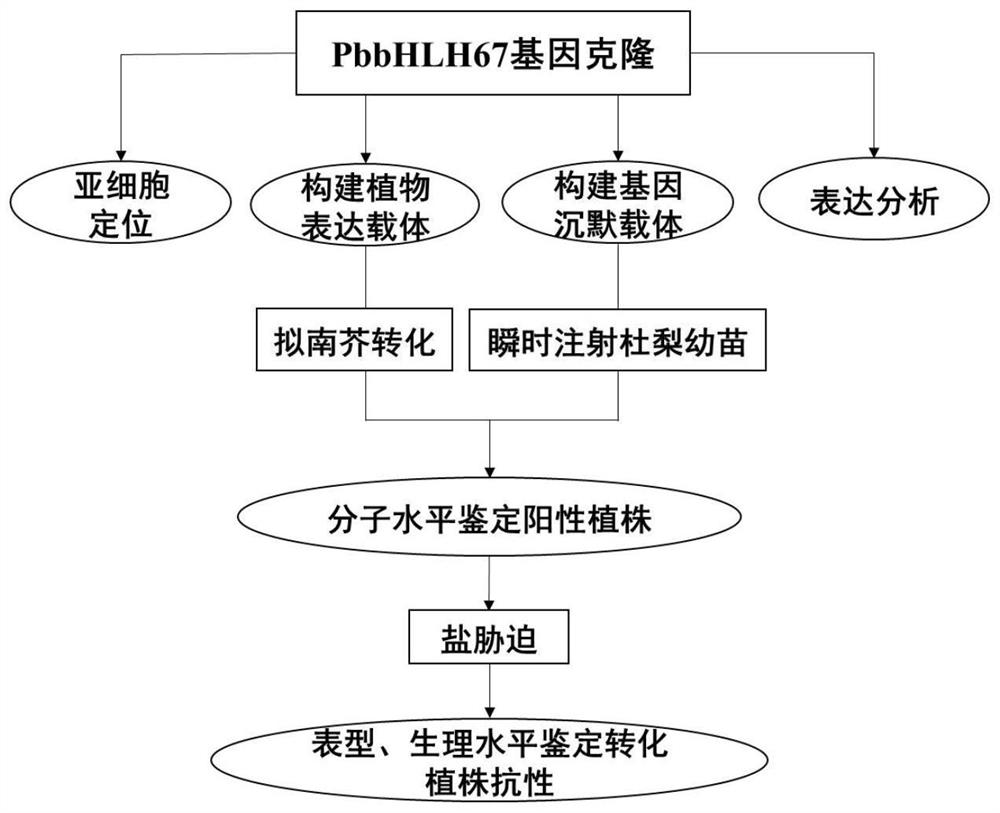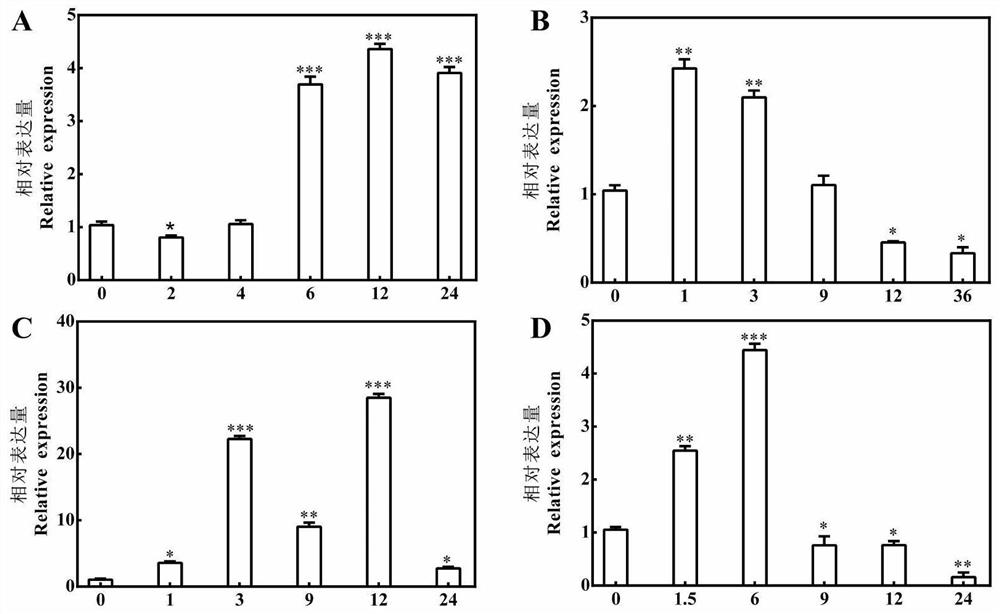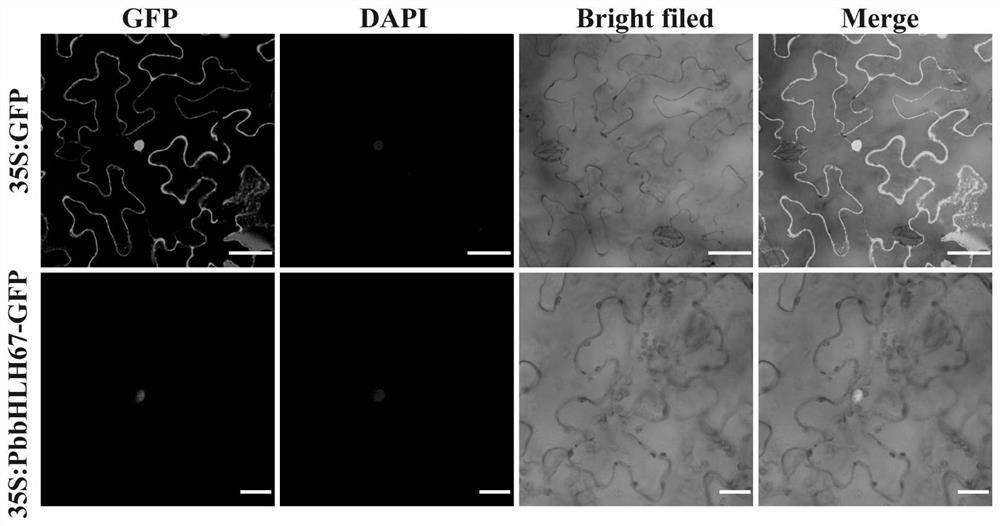Pyrus betulaefolia salt-tolerant gene, protein, recombinant vector and application
A technology of salt-tolerant genes and recombinant vectors, applied in the field of genetic engineering, can solve problems such as self-incompatibility, inability to obtain high-quality varieties efficiently, and long growth cycle
- Summary
- Abstract
- Description
- Claims
- Application Information
AI Technical Summary
Problems solved by technology
Method used
Image
Examples
Embodiment 1
[0035] Cloning of full-length cDNA of PbbHLH67 gene in Duli pear
[0036] Using an efficient yeast expression system, a basic helix-loop-helix transcription factor PbbHLH67 was screened from Du pear, and primers were designed according to the sequence of the PbbHLH67 gene (SEQ ID NO.3: ATGGAGAATGATTTTTTCCTAAATGC, SEQ ID NO.4: GAGCTCAATTTTCATGTGCGATAC), The full length of Du pear was amplified by RT-PCR method. The detailed steps are as follows: 1 μg of Du pear RNA was treated with 1 U of DNaseI at 37°C for 30 minutes and immediately placed on ice, and 1 μL of 50mM EDTA was added and treated at 65°C for 10 minutes and immediately placed on ice. The synthesis of the first strand of cDNA was carried out according to the operation manual of Quanshi Gold Reverse Transcription Kit. The resulting first-strand cDNA was used for amplification of the PbbHLH67 gene. PCR was completed according to the following procedures: pre-denaturation at 94°C for 3 min; denaturation at 94°C for 30 ...
Embodiment 2
[0040] qRT-PCR analysis of PbbHLH67 gene under different stress conditions
[0041] In order to analyze the response pattern of PbbHLH67 gene to low temperature, ABA, high salinity and drought in Duli pear, the expression pattern of PbbHLH67 gene was analyzed using Real-time PCR technology. The RNA was extracted by the CTAB method, and the synthesis of the first strand of DNA was carried out according to the operation manual of the TOYOBO reverse transcription kit. In a 20 μL reaction system: 10 μL 2×Mix, 0.1 μL cDNA, 5 μL primers (Tubulin as internal reference primer (SEQ ID NO.7: TGGGCTTTGCTCCTCTTAC, SEQ ID NO.8: CCTTCGTGCTCATCTTACC), length 208, 4.9 μL water) . The primers designed for the PbbHLH67 gene include:
[0042] SEQ ID NO.5: CCCCTTGGATAATACCTCCACC;
[0043] SEQ ID NO. 6: TTCACCAAATGCTGGAAACTG.
[0044] The program of quantitative PCR was: pre-denaturation at 95°C for 3 min; denaturation at 95°C for 3 s, annealing at 60°C for 10 s, extension at 72°C for 30 s, 45...
Embodiment 3
[0047] Subcellular localization of the gene encoding PbbHLH67
[0048] According to the PbbHLH67 nucleotide sequence and the pJIT166-GFP vector map, XbaI and BamHI restriction sites were added before and after the gene sequence. The target gene extraction plasmid with correct sequencing results was used as a template, and amplified with primers (SEQ ID NO.9 and SEQ ID NO.10) with added restriction sites. The PCR program used was: 94°C pre-denaturation for 3 minutes; 94°C denaturation 30s, annealing at 58°C for 60s, extension at 72°C for 90s, 35 cycles; extension at 72°C for 10min. The stop codon TAG was removed from the 3' of the gene in order to allow the expression of the gene as a fusion with GFP. After the PCR product was subjected to 1% agarose gel electrophoresis, the target band was recovered using a gel kit. The pJIT166-GFP vector plasmid was digested with XbaI and BamHI restriction endonucleases, purified and recovered after digestion at 37°C for 4 hours. The diges...
PUM
| Property | Measurement | Unit |
|---|---|---|
| Isoelectric point | aaaaa | aaaaa |
| Molecular weight | aaaaa | aaaaa |
Abstract
Description
Claims
Application Information
 Login to View More
Login to View More - R&D
- Intellectual Property
- Life Sciences
- Materials
- Tech Scout
- Unparalleled Data Quality
- Higher Quality Content
- 60% Fewer Hallucinations
Browse by: Latest US Patents, China's latest patents, Technical Efficacy Thesaurus, Application Domain, Technology Topic, Popular Technical Reports.
© 2025 PatSnap. All rights reserved.Legal|Privacy policy|Modern Slavery Act Transparency Statement|Sitemap|About US| Contact US: help@patsnap.com



